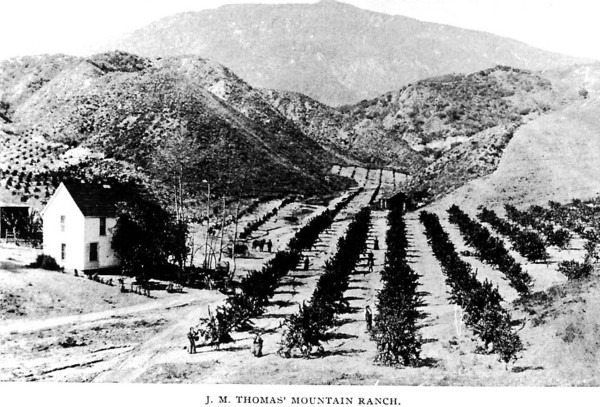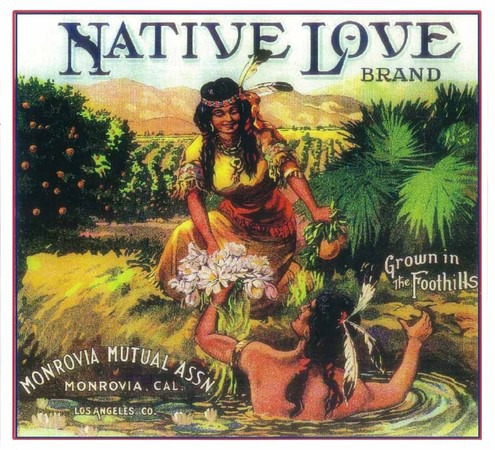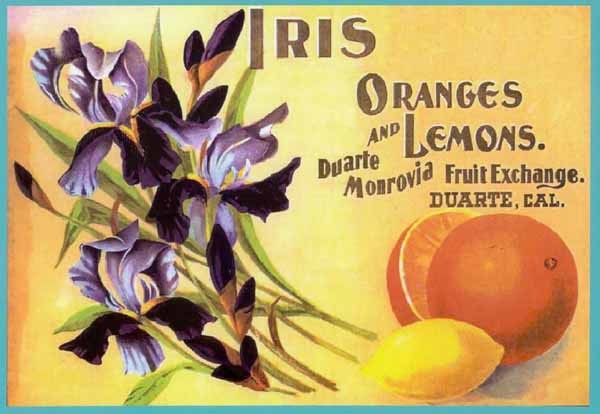http://monrovia.patch.com/articles/orange-trees-define-the-early-monrovia-landscape
Orange Trees Define the Early Monrovia Landscape
Before the population of Monrovia exploded and houses began to crowd the area, orange and other fruit groves were a dominant feature of the region.
By Jim Wigton - April 22, 2012
When early settlers began arriving in 1886 in the area that was to soon become Monrovia, they purchased land, partly to build on and partly for speculation. But the construction of homes and businesses proceeded slowly [by early 1887 there were only two homes north of White Oak (Foothill) between Myrtle and Mayflower], so much of the land was planted with fruit trees, primarily citrus, and most of the citrus was orange trees.
Early photographs of the town show it heavily populated with orange trees, as the climate in the area was ideal for growing citrus. Water from nearby Sawpit Canyon was plentiful. C.O Monroe, a brother of town founder William M. Monroe, was the first in Monrovia to clear land from the brush for the purpose of growing oranges, although ranches in the Duarte area were producing before the arrival of William Monroe in 1884.
There were a number of ranches even within the city limits of Monrovia in those early days. Cyrus Uphams ranch was located on White Oak Avenue (Foothill Boulevard) at the western limits of town and comprised 30 acres 18 acres in oranges, 7 acres in olives, and 5 acres in prunes. According to the December 18, 1890, Monrovia Messenger, The orange planting business is booming. J.F. Falvy will in January set out 30 acres in Monrovia. His land is west of the schoolhouse and runs from Orange to the Rapid Transit Railway.
The quality of fruit produced was said to rival that of Riverside who at the time had a well-deserved reputation for the excellence of the oranges it harvested. Indeed, the Los Angeles Times reported on Monrovia in January, 1889, that the orange groves are among the finest in the state. The volume of produce from not only Monrovia but including areas all the way to Riverside was such that by August, 1907, a total of 26,406 carloads of oranges and lemons had been marketed east of the Rocky Mountains from Southern California.
The vast orange and fruit orchards gave birth to a new industry in the area, that of fruit drying. During the week of June 26, 1890, less than a week after the firm of John M. Leslie & Company decided to start a fruit drying establishment, fifty young ladies and men set to work cutting apricots, removing the pit and spreading the fruit on trays. A month later, they were drying six to ten tons a day. By September, 1890, they were able to ship $37,000 worth of dried fruit in one day.
As late as 1897 when the Monrovia Messenger published its 24 page souvenir edition, extolling the virtues of Monrovia, it stated, There are large tracts of good fruit land in this immediate neighborhood that may be had at reasonable rates.
But as land became more valuable and the population of Monrovia continued to grow, orange and other fruit groves suffered an irreversible decline, giving way to housing, businesses, and streets. Gradually, the ubiquitous orange ranches faded from the scene. Today, only the occasional backyard citrus tree stands as a reminder of what the area once was like.
 1. John M. Thomas forty acre ranch (circa 1897), with twenty acres of orange, lemon, and
1. John M. Thomas forty acre ranch (circa 1897), with twenty acres of orange, lemon, and
deciduous trees, was located in Clover Leaf Canyon, in the hills above Alta Vista Avenue.
Credit Monrovia Messenger, 1897
 2. The Duarte-Monrovia Fruit Exchange (circa 1897) existed to pack and sell the citrus fruits of its
2. The Duarte-Monrovia Fruit Exchange (circa 1897) existed to pack and sell the citrus fruits of its
members. Workers would get from $1.25 to $2.00 per day, depending on ability. The grader was run
by water power from a nearby reservoir. Credit Monrovia Messenger, 1897
 Credit Jim Wigton
Credit Jim Wigton
 4. The Iris label for the Duarte-Monrovia Fruit Exchange shows that even back then the iris was a
4. The Iris label for the Duarte-Monrovia Fruit Exchange shows that even back then the iris was a
popular flower in Monrovia. Each year, Monrovia votes someone as Citizen of the Year, with the
Iris Award going to the named individual. Credit Jim Wigton 






